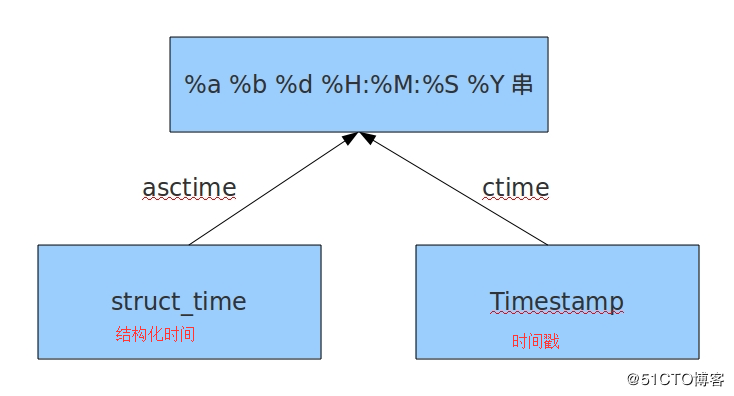常用的python模块
发布时间:2019-07-17 10:08:44编辑:auto阅读(1790)
一、time与datetime模块
1、在Python中,通常有这几种方式来表示时间:
时间戳(timestamp):通常来说,时间戳表示的是从1970年1月1日00:00:00开始按秒计算的偏移量
格式化的时间字符串(Format String)
结构化的时间(struct_time):struct_time元组共有9个元素共九个元素:(年,月,日,时,分,秒,一年中第几周,一年中第几天,夏令时)
import time
print(time.time()) # 时间戳:1515302219.4076796
print(time.strftime("%Y-%m-%d %X")) #格式化的时间字符串:2018-01-07 13:16:59
print(time.localtime()) #本地时区的struct_time,time.struct_time(tm_year=2018, tm_mon=1, tm_mday=7, tm_hour=13, tm_min=16, tm_sec=59, tm_wday=6, tm_yday=7, tm_isdst=0)
print(time.gmtime()) #UTC时区的struct_time,time.struct_time(tm_year=2018, tm_mon=1, tm_mday=7, tm_hour=5, tm_min=16, tm_sec=59, tm_wday=6, tm_yday=7, tm_isdst=0)2、三种时间表示方法之间的转换
(1)将一个时间戳转换为当前时区的struct_time
print(time.localtime(1473525444.037215)) #结果time.struct_time(tm_year=2016, tm_mon=9, tm_mday=11, tm_hour=0, tm_min=37, tm_sec=24, tm_wday=6, tm_yday=255, tm_isdst=0)
(2)将一个时间戳转换为UTC时区的struct_time
print(time.gmtime(1473525444.037215)) #结果time.struct_time(tm_year=2016, tm_mon=9, tm_mday=10, tm_hour=16, tm_min=37, tm_sec=24, tm_wday=5, tm_yday=254, tm_isdst=0)
(3)将一个struct_time转化为时间戳
print(time.mktime(time.localtime())) #当前时间转换为时间戳1515302770.0
(4)将一个struct_time转化为格式化的时间字符串
print(time.strftime("%Y-%m-%d %X", time.localtime())) #当前时间转换为格式化的时间字符串2018-01-07 13:34:20(5)将一个格式化的时间字符串转换为struct_time
print(time.strptime('2018-01-07 13:34:26', '%Y-%m-%d %X')) #time.struct_time(tm_year=2018, tm_mon=1, tm_mday=7, tm_hour=13, tm_min=34, tm_sec=26, tm_wday=6, tm_yday=7, tm_isdst=-1)(6)将一个格式化的时间字符串转换为时间戳
print(time.mktime(time.strptime('2018-01-07 13:34:26', "%Y-%m-%d %H:%M:%S"))) #结果1515303266.0(7)将时间戳转换为格式化的时间字符串
a = 1515302770.0
b = time.localtime(a)
print(time.strftime("%Y-%m-%d %H:%M:%S", b)) #结果2018-01-07 13:26:10
3、把一个表示时间的元组或者struct_time表示为这种形式:'Sun Jun 20 23:21:05 1993'
print(time.asctime()) #结果Sun Jan 7 14:03:39 2018 print(time.ctime()) #结果Sun Jan 7 14:03:39 2018

4、模块datetime
import datetime print(datetime.datetime.now()) #返回 2018-01-07 14:08:16.536681 print(datetime.date.fromtimestamp(time.time()) ) # 时间戳直接转成日期格式2018-01-07 print(datetime.datetime.now() ) #2018-01-07 14:08:16.536681 print(datetime.datetime.now() + datetime.timedelta(3)) #当前时间+3天 print(datetime.datetime.now() + datetime.timedelta(-3)) #当前时间-3天 print(datetime.datetime.now() + datetime.timedelta(hours=3)) #当前时间+3小时 print(datetime.datetime.now() + datetime.timedelta(minutes=30)) #当前时间+30分 c_time = datetime.datetime.now() print(c_time.replace(minute=3,hour=2)) #时间替换,把当前时间分钟变为3,小时变为2,结果2018-01-07 02:03:16.536681
二、 logging模块
1、日志级别
CRITICAL = 50 ERROR = 40 WARNING = 30 #默认日志级别 INFO = 20 DEBUG = 10 NOTSET = 0 #不设置
2、format参数中可能用到的格式化串说明
%(name)s:Logger的名字,并非用户名,详细查看 %(levelno)s:数字形式的日志级别 %(levelname)s:文本形式的日志级别 %(pathname)s:调用日志输出函数的模块的完整路径名,可能没有 %(filename)s:调用日志输出函数的模块的文件名 %(module)s:调用日志输出函数的模块名 %(funcName)s:调用日志输出函数的函数名 %(lineno)d:调用日志输出函数的语句所在的代码行 %(created)f:当前时间,用UNIX标准的表示时间的浮 点数表示 %(relativeCreated)d:输出日志信息时的,自Logger创建以 来的毫秒数 %(asctime)s:字符串形式的当前时间。默认格式是 “2003-07-08 16:49:45,896” %(thread)d:线程ID。可能没有 %(threadName)s:线程名。可能没有 %(process)d:进程ID。可能没有 %(message)s:用户输出的消息
实例:日志打印到access.log文件里
import logging
logging.basicConfig(filename='access.log',
format='%(asctime)s - %(name)s - %(levelname)s -%(module)s: %(message)s',
datefmt='%Y-%m-%d %H:%M:%S %p',
level=10)
logging.debug('调试debug')
logging.info('消息info')
logging.warning('警告warn')
logging.error('错误error')
logging.critical('严重critical')3、logging模块的Formatter,Handler,Logger,Filter对象
logger:产生日志的对象
Filter:过滤日志的对象
Handler:接收日志然后控制打印到不同的地方,FileHandler用来打印到文件中,StreamHandler用来打印到终端
Formatter对象:可以定制不同的日志格式对象,然后绑定给不同的Handler对象使用,以此来控制不同的Handler的日志格式
4、输出日志流程
'''
critical=50
error =40
warning =30
info = 20
debug =10
'''
import logging
(1)logger对象:负责产生日志,然后交给Filter过滤,然后交给不同的Handler输出
logger=logging.getLogger(__file__)
(2)Filter对象:不常用,略
(3)Handler对象:接收logger传来的日志,然后控制输出方式
h1=logging.FileHandler('t1.log') #打印到文件
h2=logging.FileHandler('t2.log') #打印到文件
h3=logging.StreamHandler() #打印到终端
(4)Formatter对象:日志格式
formmater1=logging.Formatter('%(asctime)s - %(name)s - %(levelname)s -%(module)s: %(message)s',
datefmt='%Y-%m-%d %H:%M:%S %p',)
formmater2=logging.Formatter('%(asctime)s : %(message)s',
datefmt='%Y-%m-%d %H:%M:%S %p',)
formmater3=logging.Formatter('%(name)s %(message)s',)
(5)为Handler对象绑定格式
h1.setFormatter(formmater1)
h2.setFormatter(formmater2)
h3.setFormatter(formmater3)
(6)将Handler添加给logger并设置日志级别
logger.addHandler(h1)
logger.addHandler(h2)
logger.addHandler(h3)
logger.setLevel(10)
(7)测试
logger.debug('debug')
logger.info('info')
logger.warning('warning')
logger.error('error')
logger.critical('critical')5、设置级别
logger是第一级过滤,然后才能到handler,我们可以给logger和handler同时设置level,但是需要注意的是:
logger的级别小于等于handler的级别,否则日志会在logger时就被过滤
6、logger应用
(1)logging配置文件
import os
import logging.config
standard_format = '[%(asctime)s][%(threadName)s:%(thread)d][task_id:%(name)s][%(filename)s:%(lineno)d]' \
'[%(levelname)s][%(message)s]' #其中name为getlogger指定的名字
simple_format = '[%(levelname)s][%(asctime)s][%(filename)s:%(lineno)d]%(message)s'
id_simple_format = '[%(levelname)s][%(asctime)s] %(message)s'
logfile_dir = os.path.dirname(os.path.abspath(__file__)) # log文件的目录
logfile_name = 'access.log' # log文件名
# 如果不存在定义的日志目录就创建一个
if not os.path.isdir(logfile_dir):
os.mkdir(logfile_dir)
logfile_path = os.path.join(logfile_dir, logfile_name)
# log配置字典
LOGGING_DIC = {
'version': 1,
'disable_existing_loggers': False,
'formatters': {
'standard': {
'format': standard_format
},
'simple': {
'format': simple_format
},
},
'filters': {},
'handlers': {
#打印到终端的日志
'console': {
'level': 'DEBUG',
'class': 'logging.StreamHandler', # 打印到屏幕
'formatter': 'simple'
},
#打印到文件的日志,收集info及以上的日志
'default': {
'level': 'DEBUG',
'class': 'logging.handlers.RotatingFileHandler', # 保存到文件
'formatter': 'standard',
'filename': logfile_path, # 日志文件
'maxBytes': 1024*1024*5, # 日志大小 5M
'backupCount': 5,
'encoding': 'utf-8', # 日志文件的编码,再也不用担心中文log乱码了
},
},
'loggers': {
#logging.getLogger(__name__)拿到的logger配置
'': {
'handlers': ['default', 'console'], # 这里把上面定义的两个handler都加上,即log数据既写入文件又打印到屏幕
'level': 'DEBUG',
'propagate': True, # 向上(更高level的logger)传递
},
},
}
def load_my_logging_cfg():
logging.config.dictConfig(LOGGING_DIC) # 导入上面定义的logging配置
logger = logging.getLogger(__name__) # 生成一个log实例
logger.info('It works!') # 记录该文件的运行状态
if __name__ == '__main__':
load_my_logging_cfg()(2)logger使用
import time
import logging
import my_logging # 导入自定义的logging配置
logger = logging.getLogger(__name__) # 生成logger实例
def demo():
logger.debug("start range... time:{}".format(time.time()))
logger.info("中文测试开始。。。")
for i in range(10):
logger.debug("i:{}".format(i))
time.sleep(0.2)
else:
logger.debug("over range... time:{}".format(time.time()))
logger.info("测试结束。。。")
if __name__ == "__main__":
my_logging.load_my_logging_cfg() # 在你程序文件的入口加载自定义logging配置
demo()三、re模块(正则模块)
1、正则就是用一些具有特殊含义的符号组合到一起(称为正则表达式)来描述字符或者字符串的方法。
2、正则表达式元字符说明
. 匹配除换行符以外的任意字符
^ 匹配字符串的开始
$ 匹配字符串的结束
[] 用来匹配一个指定的字符类别
? 对于前一个字符字符重复0次到1次
* 对于前一个字符重复0次到无穷次
{} 对于前一个字符重复m次
{m,n} 对前一个字符重复为m到n次
\d 匹配数字,相当于[0-9]
\D 匹配任何非数字字符,相当于[^0-9]
\s 匹配任意的空白符,相当于[ fv]
\S 匹配任何非空白字符,相当于[^ fv]
\w 匹配任何字母数字字符,相当于[a-zA-Z0-9_]
\W 匹配任何非字母数字字符,相当于[^a-zA-Z0-9_]
\b 匹配单词的开始或结束,print(re.findall(r'er\b','never hello word 123'))
3、正则匹配
import re
#\w与\W
print(re.findall('\w','hello\t word\n 123')) #['h', 'e', 'l', 'l', 'o', 'w', 'o', 'r', 'd', '1', '2', '3']
print(re.findall('\W','hello\t egon\n 123')) #['\t', ' ', '\n', ' ']
#\s与\S
print(re.findall('\s','hello\t word\n 123')) #['\t', ' ', '\n', ' '],\n \t都是空,都可以被\s匹配
print(re.findall('\S','hello\t word\n 123')) #['h', 'e', 'l', 'l', 'o', 'w', 'o', 'r', 'd', '1', '2', '3']
#\n与\t
print(re.findall('\n','hello\t word\n 123')) #['\n']
print(re.findall('\t','hello\t word\n 123')) #['\t']
#\d与\D
print(re.findall('\d','hello\t word\n 123')) #['1', '2', '3']
print(re.findall('\D','hello\t word\n 123')) #['h', 'e', 'l', 'l', 'o', '\t', ' ', 'w', 'o', 'r', 'd', '\n', ' ']
#\A与\Z
print(re.findall('\Ahe','hello\t word\n 123')) #['he'],相当于^
print(re.findall('123\Z','hello\t word\n 123')) #['123'],相当于$
#^与$
print(re.findall('\Ah','hello\t word\n 123')) #['h']
print(re.findall('123\Z','hello\t word\n 123')) #['123']4、重复匹配:| . | * | ? | .* | .*? | + | {n,m} |
#.
print(re.findall('a.b','a1b a*b a b aaab')) #['a1b', 'a*b', 'a b', 'aab']
print(re.findall('a.b','a\nb')) #[],不匹配换行符
print(re.findall('a.b','a\nb',re.S)) #['a\nb']
print(re.findall('a.b','a\nb',re.DOTALL)) #['a\nb']同上一条意思一样
#*
print(re.findall('ab*','abbbb bbbbbbb a')) #['abbbb', 'a']
#?
print(re.findall('ab?','abbb a bbbbbb')) #['ab', 'a']
#匹配所有包含小数在内的数字
print(re.findall('\d+\.?\d*',"adf123as1.13dfa12adsf1asdf3")) #['123', '1.13', '12', '1', '3']
#.* 默认为贪婪匹配
print(re.findall('a.*b','a1b22222222b')) #['a1b22222222b']
#.*? 为非贪婪匹配:推荐使用
print(re.findall('a.*?b','a1b22222222b')) #['a1b']
#+
print(re.findall('ab+','a')) #[]
print(re.findall('ab+','abbb a ab')) #['abbb', 'ab']
#{n,m} 指定匹配字符的次数
print(re.findall('ab{2}','abbb')) #['abb']
print(re.findall('ab{2,4}','abbb')) #['abb']
print(re.findall('ab{1,}','abbb')) #'ab{1,}',匹配ab,其中b至少有1个,相当于 'ab+'
print(re.findall('ab{0,}','abbb')) #'ab{0,}' ,匹配ab,其中b可以没有,也可以有多个,'ab*'
#[]
print(re.findall('a[1*-]b','a1b a*b a-b')) #[]内的都为普通字符了,且如果-没有被转意的话,应该放到[]的开头或结尾,['a1b', 'a*b', 'a-b']
print(re.findall('a[^1*-]b','a1b a*b a-b a=b')) #[]内的^代表的意思是取反,所以结果为['a=b']
print(re.findall('a[a-z]b','a1b a*b a-b a=b aeb')) #结果为['aeb']
print(re.findall('a[a-zA-Z]b','a1b a*b a-b a=b aeb aEb')) #['aeb', 'aEb']
print(re.findall(r'a\\c','a\c')) #r代表告诉解释器使用rawstring,即原生字符串,把我们正则内的所有符号都当普通字符处理,不要转义,['a\\c']
#():分组
print(re.findall('ab+','ababab123')) #['ab', 'ab', 'ab']
print(re.findall('(ab)+123','ababab123')) #['ab'],匹配到末尾的ab123中的ab
print(re.findall('(?:ab)+123','ababab123')) #findall的结果不是匹配的全部内容,而是组内的内容,?:可以让结果为匹配的全部内容
print(re.findall('href="(.*?)"','<a href="http://www.baidu.com">点击</a>'))#['http://www.baidu.com']
print(re.findall('href="(?:.*?)"','<a href="http://www.baidu.com">点击</a>'))#['href="http://www.baidu.com"']
#|
print(re.findall('compan(?:y|ies)','companies my company comparies')) #结果是['companies', 'company']5、re模块提供的方法介绍
print(re.findall('e','make love') ) #['e', 'e'],返回所有满足匹配条件的结果,放在列表里
print(re.search('e','make love').group()) #e,只到找到第一个匹配然后返回一个包含匹配信息的对象,该对象可以通过调用group()方法得到匹配的字符串,如果字符串没有匹配,则返回None。
print(re.match('e','alex make love')) #None,同search,不过在字符串开始处进行匹配,完全可以用search+^代替match
print(re.split('[ab]','abcd')) #['', '', 'cd'],先按'a'分割得到''和'bcd',再对''和'bcd'分别按'b'分割
print(re.sub('a','A','alex make love')) #Alex mAke love,不指定n,默认替换所有
print(re.sub('a','A','alex make love',1)) #Alex make love,最后的1指的是替换的个数
print(re.sub('^(\w+)(.*?\s)(\w+)(.*?\s)(\w+)(.*?)$',r'\5\2\3\4\1','alex make love')) #love make alex
print(re.subn('a','A','alex make love')) #('Alex mAke love', 2),结果带有总共替换的个数
obj=re.compile('\d{2}')
print(obj.search('abc123eeee').group()) #12
print(obj.findall('abc123eeee')) #['12'],重用了obj
上一篇: python 字符串
下一篇: python import 与 from
- openvpn linux客户端使用
51783
- H3C基本命令大全
51473
- openvpn windows客户端使用
41874
- H3C IRF原理及 配置
38650
- Python exit()函数
33143
- openvpn mac客户端使用
30129
- python全系列官方中文文档
28807
- python 获取网卡实时流量
23797
- 1.常用turtle功能函数
23713
- python 获取Linux和Windows硬件信息
22081
- Ubuntu本地部署dots.ocr
142°
- Python搭建一个RAG系统(分片/检索/召回/重排序/生成)
2308°
- Browser-use:智能浏览器自动化(Web-Agent)
3003°
- 使用 LangChain 实现本地 Agent
2506°
- 使用 LangChain 构建本地 RAG 应用
2454°
- 使用LLaMA-Factory微调大模型的function calling能力
3075°
- 复现一个简单Agent系统
2459°
- LLaMA Factory-Lora微调实现声控语音多轮问答对话-1
3275°
- LLaMA Factory微调后的模型合并导出和部署-4
5391°
- LLaMA Factory微调模型的各种参数怎么设置-3
5210°
- 姓名:Run
- 职业:谜
- 邮箱:383697894@qq.com
- 定位:上海 · 松江
